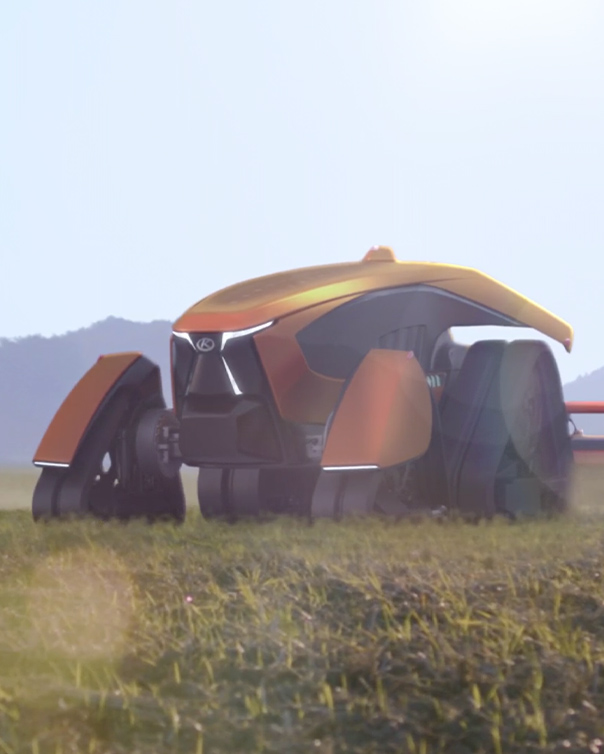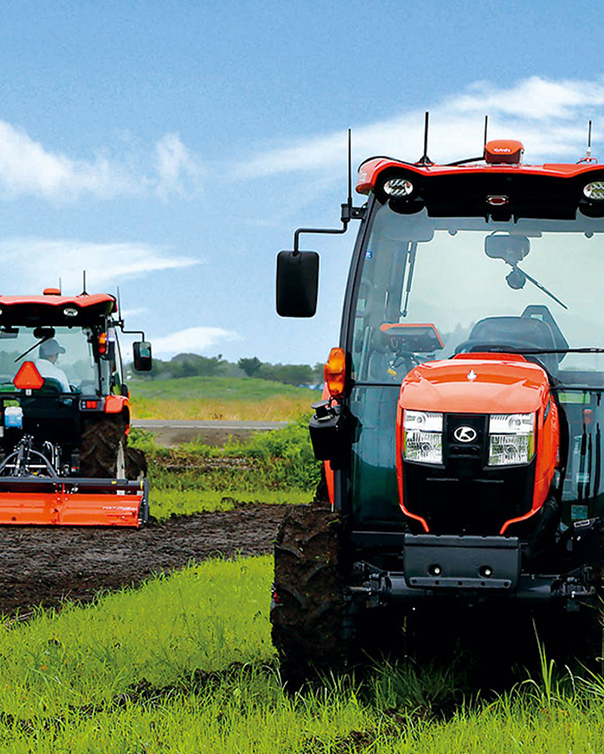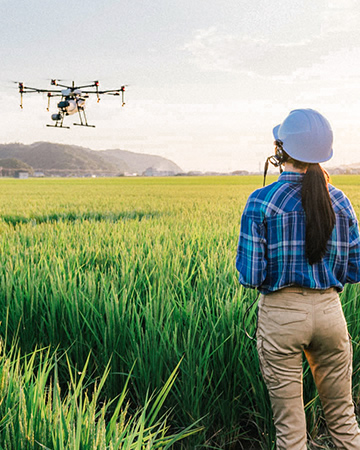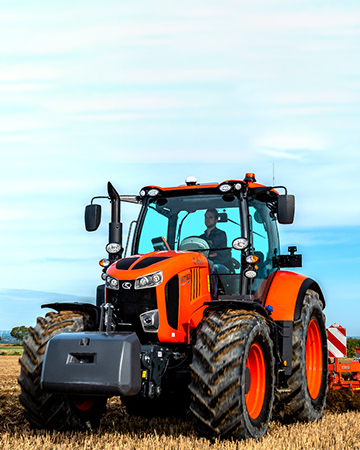
5G has been gaining notice as the next generation of communication systems. With telecom carriers touting high-speed data in their commercials and the release of one 5G-compatible smartphone after another, 5G is gradually beginning to spread throughout our daily lives.
5G holds the possibility to offer great advancements in both individual lives and a variety of industries. Agriculture is no exception, and the areas of autonomous agricultural machinery and data-driven smart agriculture are also expected to evolve significantly through 5G. In this article, we will focus on the changes that 5G will bring to agriculture through Kubota’s vision for the future of smart agriculture.
Kubota’s Vision for the Future of Smart Agriculture
In Japan, due to the aging of farmers and other trends, the number of agricultural workers continues to decrease. This has resulted in a growing number of farmers leaving agriculture and a shortage of labor on farms. Farmers are giving up their land or outsourcing their operations, leading to consolidation of farms. Proper management of this consolidated land and the increased workload are just some of the issues that have arisen, and there is an urgent need for assistance to the farmers facing these problems.
To address these issues, expectations are rising for smart agriculture, which utilizes ICT and robotics to achieve ultra-labor saving and higher quality in production. Kubota is one of the first agricultural machinery manufacturers in Japan to begin implementation of smart agriculture into society. The company has focused its research and development on automated and unmanned agricultural machinery as well as precision agriculture that utilizes data, aiming for a future of smart agriculture that reduces farmers' burden and achieves better productivity.
Kubota's Goals for Achieving Automated Agricultural Machinery and Precision Farming
Ultra-Labor Saving through Automated and Unmanned Agricultural Machinery
To increase the types of work that can be done by agricultural machinery in fields*1 under remote monitoring and make it so that unmanned operations can be performed in multiple fields.
- *1.Fields: Areas of farmland on which crops are raised.
Precision Farming Based on Data Utilization
To analyze growth data, environmental data from fields, yield data, market data, and other information collected from agricultural machinery and drones, and enable measures including formulation of crop plans in order to improve the efficiency of data-driven farm management. To achieve waste-free, profitable, and sustainable agriculture in which the required crops can be grown and harvested in the required amounts at the required times.
Realizing this smart agriculture would enable Kubota to provide value to farmers in various ways. One example is making agriculture more profitable through increased productivity, reduced burden on workers and labor-saving. In addition, R&D is currently under way for smart agriculture in rice paddy farming, but Kubota aims to provide wide-reaching value in dry-field farming through automated and unmanned agricultural machinery and the utilization of data.
Examples of Value Provided by Kubota through Smart Agriculture
Making agriculture profitable by improving productivity
- Producing the required crops at the required times in the required amounts
- Improving yield and flavor per unit area
- Enabling large fields to be covered by one person
- Reducing fertilizer and pesticide waste through data-driven application
- Linking with Kubota Smart Agri System and automated agricultural machinery to prevent errors in fields and fertilizer amounts
and more
Work reduction/labor-saving
- Eliminating burdensome work and changing work styles by automating agricultural machinery, etc.
- Reducing workloads by increasing types of work that can be done by automated agricultural machinery
and more
Reducing environmental impact
- Optimizing the use of fertilizers, pesticides, and water based on data, and adapting to organic farming
and more
Maintaining multifaceted functions of agriculture
- Enabling utilization of abandoned farmland by making expansion easier
- Realizing sustainable agriculture that is resistant to climate change
and more
One of the elements required for achieving this smart agriculture system of the future is 5G, the next-generation communications system.
The Potential of Smart Agriculture & 5G
There are three major features of 5G that make it different from communications systems of the past.
The first is its ultra-high speed. It is 100 times faster than 4G and is said to let users download a two-hour movie in three seconds. The second is its ultra-low latency. Users can remotely control a robot in real time without feeling any delay or time lag. The third is its multiple simultaneous connections. It will allow smartphones, PCs, and all kinds of other devices around us to be connected to the internet.
These features will accelerate the evolution of smart agriculture. The main areas of advancement will be remote monitoring and control of farm machinery, remote sensing, and compatibility with dry-field crops.
Improving Reliability of Remote Monitoring and Control
To realize simultaneous work by multiple agricultural machines in the field under remote monitoring, farmers must be able to monitor a wide area and control the machines dependably. The use of 5G, which enables ultra-low latency communications and multiple simultaneous connections, makes it possible to monitor and control multiple machines and detect people and obstacles in real time.

If the remote monitoring function is improved, one farmer will be able to monitor and control multiple autonomous agricultural machines from home or another location far from the field. This will increase the amount of area a single farmer can cover during limited cropping seasons, enabling support for large-scale farming operations.
Improving Accuracy and Efficiency of Remote Sensing
5G will also have a tremendous impact on remote sensing, in which agricultural machines and drones assess the condition of fields and crops and utilize the information they collect.
High-resolution image data generally takes up large amounts of capacity, but with 5G, this data can be sent and received at high speeds. The system will collect and analyze field images over a wide range in a short time, quickly assessing the growth of crops and improving fertilizer distribution by focusing on areas with poor growth, among other services.

Furthermore, by quickly collecting large numbers of high-resolution images for AI learning, the system can improve the accuracy and processing speed of AI in a short time. As the AI advances, it will be able to suggest the next step required in the field, enabling precision agriculture that is even more data-driven.
Autonomous Agricultural Machinery that Supports Dry-Field Farming
The Kubota autonomous agricultural machinery that is currently available has been developed mainly to work on flat rice paddies. By sending and receiving high-definition image data obtained from cameras through 5G and recognizing crops and rows with greater accuracy, machines will be able to drive without crushing crops, allowing the system to also work with dry-field farming. What is more, the capability to work with various implements (work machines attached to the tractor) will expand the range of dry-field tasks that can be performed by automated agricultural machines.
5G is one of the elements that holds the key for developing smart agriculture. Once ultra-labor saving and better data utilization are realized, we can anticipate solutions to the challenges detailed above that Japanese agriculture faces, and this will lead to a stable supply of food to support our everyday lives.
Kubota is Driving Progress in the Use of 5G in Agriculture
In 2021, Kubota took part in the Ministry of Internal Affairs and Communications (MIC) Development Demonstrations for Realizing Local 5G to Solve Local Issues project in Iwamizawa, Hokkaido, as well as the Ministry of Agriculture, Forestry and Fisheries (MAFF) Smart Agriculture Demonstration Project.
These projects were a collaboration between industry, academia, government, and the private sector. Demonstrations were conducted in five fields within the local 5G*2 area, including trials for proper operation, remote monitoring, and control of unmanned automated agricultural machinery from a monitoring center located approximately 10 km from the field, along with the transmission, reception, and collection of big data, including growth data acquired from automated agricultural machinery and various sensors placed in the field.
- *2.A 5G network that can be established and operated independently by operators covering a certain area.
In this demonstration, Kubota provided agricultural machinery (tractors and combine harvesters) to use in the experiment, refurbished equipment for demonstrations of remote monitoring and control, and provided the Kubota’s water-environment IoT solution system KUBOTA Smart Infrastructure System and related equipment.

Implementing smart agriculture into society will be essential for solving the challenges facing Japanese agriculture. To achieve this goal, Kubota and other companies and organizations are working together toward the utilization of 5G in farming. Kubota is still on the way toward realizing this future, but it is making steady progress with every step.





